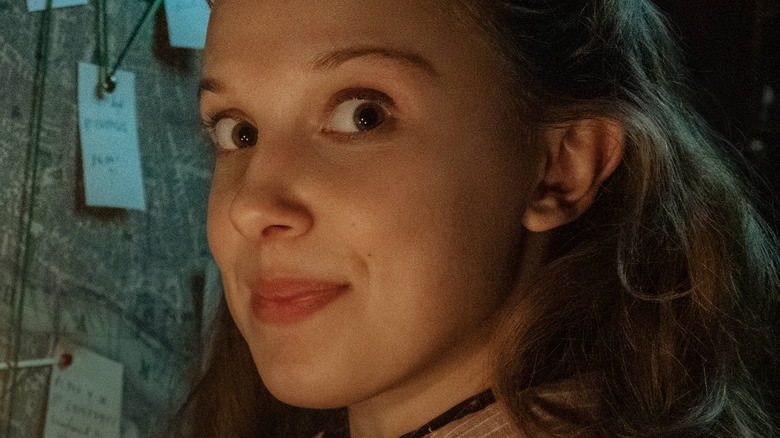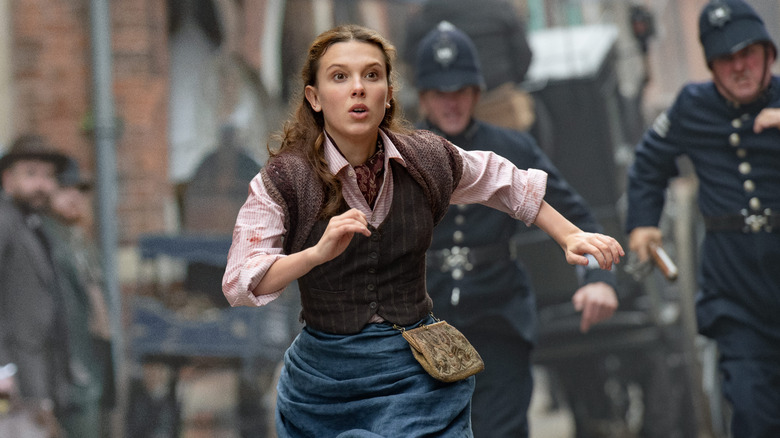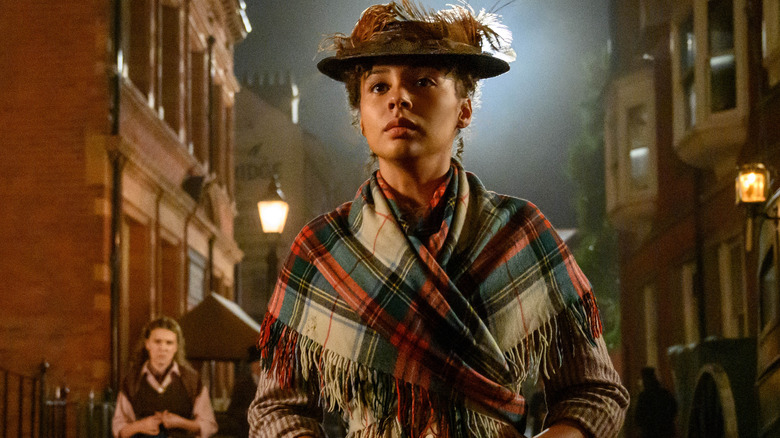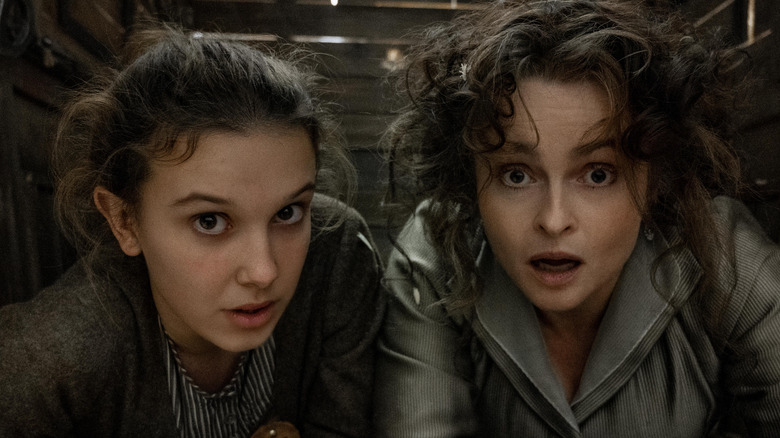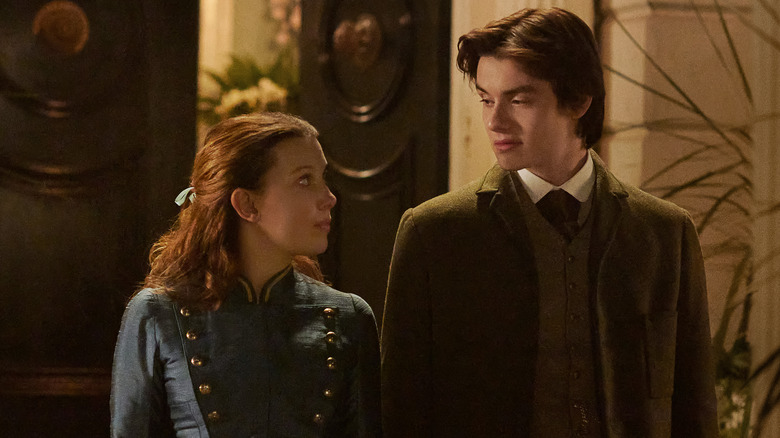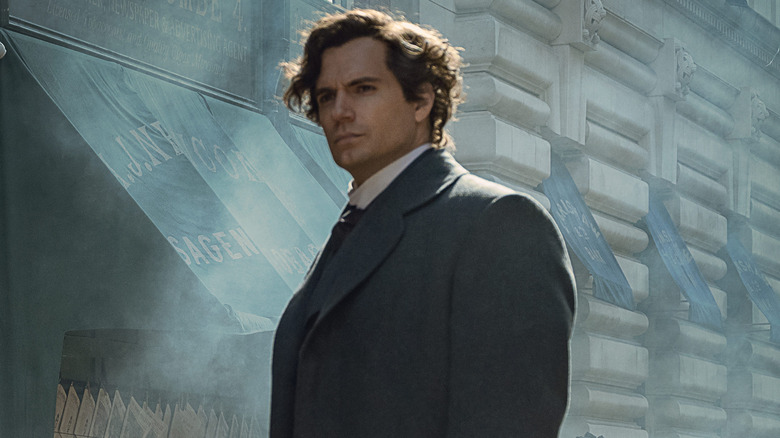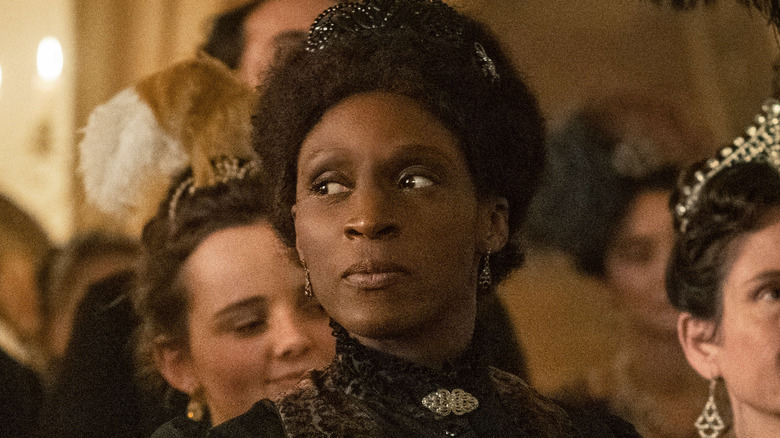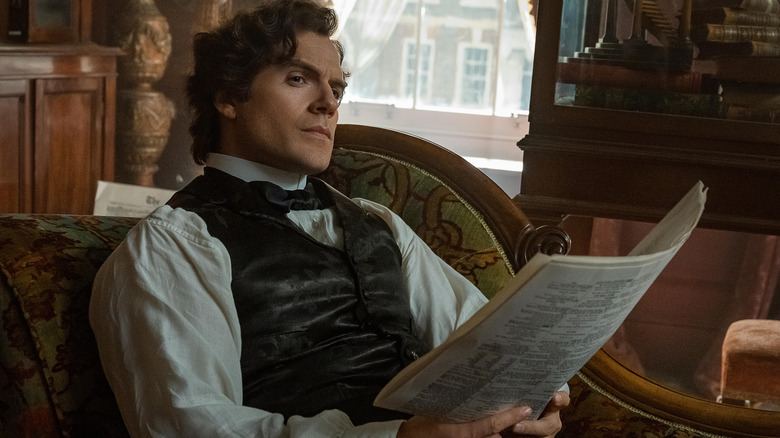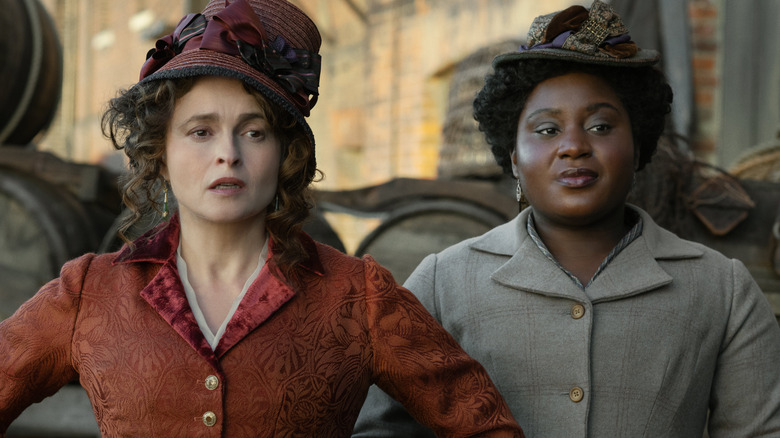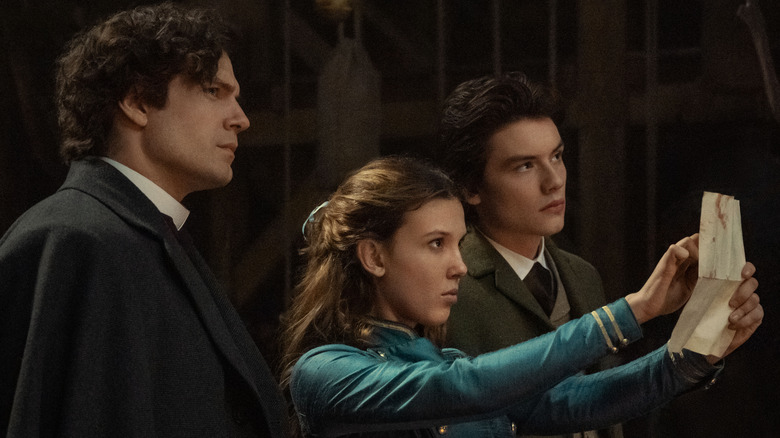The Ending Of Enola Holmes 2 Explained
Enola Holmes is back in "Enola Holmes 2," a sequel that delivers every bit as much intrigue, action, empowerment, and cheeky fourth-wall breaks as 2020's "Enola Holmes." Likewise, Millie Bobby Brown is back to give as excellent a performance as she did in the first movie, elevating an already stellar cast to new heights. For all its childlike charm, however, the movie presents a tangled plot that even the mighty Sherlock Holmes — again portrayed by the modern king of fandoms, Henry Cavill — would have to strain to solve. True to form, "Enola Holmes 2" spins its complex web of a plot slowly and carefully, leaving behind a labyrinthine network of threads to unravel.
Adorning the intricate plot are a number of themes, most of them related to personal growth and empowerment, that were set up by the first film. By the end of the new one, not only has Enola's world changed, but so have those closest to her — and even Enola herself. Unpacking those changes, their impetus, and their larger meaning requires some considerable detective skills, and luckily we here at Looper have taken the case. Here is the ending of "Enola Holmes 2" explained.
Sarah Chapman
As "Enola Holmes 2" begins to pick up speed, the plot becomes far larger, deadlier, and more meaningful than Enola could have ever imagined. What seems at first to be a simple disappearance — even simpler in fact, a straightforward instance of a young couple running away together — turns out to be just the tip of a truly disastrous iceberg.
The missing girl, an employee of the local matchstick factory named Sarah Chapman (Hannah Dodd), actually disappears because she's on a mission to expose the factory for its unsafe working conditions. Afraid that she would inadvertently put her loved ones at risk by ruffling the wrong feathers, Chapman goes into hiding, disguising herself and secretly gathering evidence against the factory owner, Henry Lyon. As surprising as these revelations are to Enola, what's potentially even more surprising is the fact that Chapman was an actual, historical figure who really did help lead a strike against the Bryant and May matchstick factory.
In one of the last scenes in "Enola Holmes 2," Chapman leads her fellow "matchgirls" to walk out of the factory and strike until the dangerous working conditions change, and on July 5, 1888, that's exactly what Chapman and her fellow strike leaders did. This means that Enola's franchise is open to including real-world events in its stories, opening an untold amount of fascinating possibilities.
Learn to dance, learn to fight
Throughout both films, one of Enola's central struggles has been to supplement her astonishing intelligence with real-world wisdom. In other words, she needs to grow up. The same is true for Lord Tewkesbury (Louis Partridge), the young hunk that catches Enola's eye early in the first movie. Both characters are impressively capable in their specific areas of expertise but lack certain core life experiences necessary to truly come into their own. In "Enola Holmes 2," these core necessities are made explicit: Enola needs to learn how to dance and Tewkesbury needs to learn how to fight.
At first, both of these needs are literal. When Enola infiltrates the Lyon family's ball, learning to waltz is the only way to get close to William Lyon (Gabriel Tierney). Meanwhile, as soon as he joins Enola's adventure, Tewkesbury needs to learn how to brawl with any potential ne'er-do-wells. However, the movie's ending makes it clear that those talents mean far more to both characters than just physical skills.
Raised as a wealthy noble, Tewkesbury lacks the courage and confidence he needs to be an effective member of the House of Lords. He needs to learn how to fight back, not just with fists, but with his words and campaigns. Raised to be stubborn and fiercely independent, Enola needs to learn how to follow social rules and "dance" to the rhythm of her peers.
Reform
Just as the principal characters in "Enola Holmes 2" are forced to evolve in order to survive the schemes and dangers they're pitted against, their very setting is forced to evolve too. The many stories of Sherlock Holmes, and now Enola as well, are set in Victorian Era London, a period when the Industrial Revolution and other modernizing movements were pushing sweeping change on the population. Technology, science, and medicine were advancing rapidly, but unfortunately, civil rights weren't quite keeping pace. Of particular interest to Enola and even more so to her mother, Eudoria Holmes (Helena Bonham Carter), is the issue of women's rights, an issue referred to throughout the movie simply as "reform."
Time and again, Enola is underestimated because of her gender, and although she's clever enough to use that to her advantage, it is nonetheless a sad and frustrating fact of her world. That same sexism plays a major role in the film, not only by partially causing the mistreatment of the matchgirls, but also by setting the entire franchise in motion. The plot of "Enola Holmes" kicks off when Eudoria vanishes, but is later revealed to be on a mission to systematically dismantle the patriarchy through acts of controlled terrorism. While Eudoria uses bombs to destroy her oppressors, Enola uses her explosive wit to impress her doubters.
Be one voice
A huge part of growing up for many film characters is learning to become independent and finally strike out on their own, but Enola's journey in "Enola Holmes 2" is precisely the opposite. Because Eudoria raised her to forge her own path and never define her worth by anyone else's standards, Enola begins the new movie completely unwilling to accept help from others. Whether it's Tewkesbury, who obviously loves her and has all the powers of a Lord, or Sherlock, the world's greatest detective, Enola always chooses to go it alone — even when it hurts her and her case. It's not until she is reunited with her mother for a warm, intimate prison escape that Enola finally hears what she needs to hear and changes her mind.
When they're alone together, Eudoria admits that she might have raised Enola to be "too independent." Seeing Enola's desperate need for help, Eudoria tells her to "find your allies, work with them, and you will become more of who you are. You speak with one voice, and you will make more noise than you could ever imagine." This is a major turning point for Enola, and soon after this, her one-woman investigation swells to include Sherlock, Tewkesbury, Chapman, and even more allies that come with them.
Enola and Tewkesbury
After two entire movies, it finally happens: Enola and Tewkesbury profess their mutual love for each other and share a romantic kiss. This is a huge moment for several reasons — Enola's happiness, her maturity, her willingness to be vulnerable to others, and her moving up in the world — and it becomes even more important when you consider all it took to get there and all it means for any future films in the series.
It was a tremendously important facet of "Enola Holmes" that Enola was alone. That movie was her against the world, the scrappy, underestimated up-and-comer against all of society. That even holds true for a large portion of "Enola Holmes 2," but as of the film's ending, the Enola we know is gone. Enola is no longer up-and-coming — she is already there. With the ability to work as a member of a team, and with the substantial aid of a member of the House of Lords, Enola's detective agency is not only legit, it might just be the best detective agency around (unless Sherlock steps up his game enough to reassert his lead). Whatever adventures lie in Enola's future, they are unlikely to be more David vs. Goliath stories. Instead, they'll be more akin to classic Sherlock Holmes stories — a master of their craft set against only the fiercest opponents and hired for only the most cryptic cases.
Holmes and Holmes
When it comes to detectives, Sherlock Holmes has always been the undisputed G.O.A.T. That's why he understandably doesn't have much professional respect for other detectives and police officers. Whenever he encounters Inspector Lestrade (Adeel Akhtar), Sherlock's attitude is at best indifferent and at worst dismissive. When it comes to Lestrade's nameless subordinate officers, Sherlock acts downright condescendingly, even dehumanizing. It's that attitude that makes Sherlock's final interaction with Enola at the end of "Enola Holmes 2" so important.
When Sherlock visits Enola in her new office, after a spate of mumbles and awkward fumblings — the exact last things you'd expect from the smartest man alive — he finally manages to offer to Enola, "I was thinking ... Holmes and Holmes? A partnership?" When Enola immediately tears up, it is understandable. This is completely unprecedented, and is the clearest sign yet that she's made it (not to mention a loving gesture from her otherwise-distant brother). In making this sincere offer, Sherlock makes it crystal clear that he respects Enola — unlike anyone else, even his close brother Mycroft (Sam Claflin), Sherlock respects Enola's powers of deduction. For Enola, this is the destination after a long, arduous journey, and for us viewers, it's a tantalizing prospect for future Enola Holmes movies.
A friend would do you well
During Sherlock and Enola's final meeting, she turns down his offer to form the Holmes and Holmes detective agency. Despite all of her love and respect for her brother, she has her own path to forge. She does, however, offer to meet Sherlock on a weekly basis, every Thursday at 4 p.m. When the first scheduled appointment rolls around, it's not Enola that knocks on the door of 221B Baker Street, but a stranger to Holmes. Led there by Enola, the stranger offers to become Sherlock's new flatmate, and then reveals his name: Dr. John Watson (Himesh Patel). Holmes has finally met Watson, all thanks to Enola, and it is guaranteed to change the franchise going forward.
It was Enola who told Sherlock, "A friend would do you well," and after introducing Sherlock and Watson, she will almost certainly be proven right. The friendship between those two has become the stuff of legend (see: the real-life friendship of Robert Downey Jr. and Jude Law), and unless any future Enola Holmes movies want to drastically disrupt the formula, it's likely that the pairing will endure. If we're lucky enough to see Enola and Sherlock actually solve crimes as the Holmes and Holmes agency, chances are that the agency will have to be renamed Holmes and Holmes and Watson.
Moriarty
In the Sherlock Holmes canon (although it isn't his alone anymore), there is only one character whose introduction could overshadow Dr. John Watson's. Longtime fans of the lore will know the answer immediately: Moriarty, Sherlock's arch-nemesis and the only person to ever match Sherlock wit for wit. In that case of "Enola Holmes 2," however, Moriarty's introduction is made all the more bold and impactful by her casting and her (albeit telegraphed) reveal — Moriarty is the alias (and anagram) of Mira Troy (Sharon Duncan-Brewster), a Black woman.
Of all the major themes in the two Enola Holmes movies, the biggest by far is the necessity and virtue of feminism and female empowerment. It drives and defines Enola in the same way that it does Eudoria and Edith (Susan Wokoma), it forms the backdrop for both films' plots, and in real life, it allows for the casting of Duncan-Brewster as Moriarty — a smart and significant choice.
The new Moriarty has so much to offer the franchise in terms of representation and storytelling. Not only is a Black woman playing one of the world's most indisputable geniuses, but also the very character of Moriarty now has more to do. Instead of two rich, noble, white men pitting their expensive educations against each other as in previous adaptations, now Moriarty has motivation, depth, and a visceral, passionate reason for lashing out like she does. Whatever role Duncan-Brewster's Moriarty will play in the future, it will be bright.
Rube Goldberg machine
Every good mystery movie has a plot within its plot, a layer of truth below whatever truths you first assume. Or, as Benoit Blanc from "Knives Out" famously put it, "The donut hole has a hole in its center. It is not a doughnut hole but a smaller doughnut with its own hole and our doughnut is not whole at all." In keeping with tradition, "Enola Holmes 2" unravels itself as plots beneath plots, all of which choose to reveal themselves only in their own time. Luckily for Enola, Eudoria taught her to see the entirety of the complex system of machinations and accurately predict the end result. Very literally, Eudoria taught Enola to handle complex problems through Rube Goldberg machines, and the final showdown at the climax of the movie ends in a giant version of one.
When Enola finally pieces together the puzzle and ascertains the meaning of Chapman's secret letters, she arrives at the Paragon Theatre. So do her enemies, chief among them Superintendent Grail (David Thewlis), the crooked cop who has hindered Enola's every move in an effort to cover up the matchgirl sicknesses. When the two finally come to blows, it happens in the midst of an intricate system of pulleys, levers, weights, and counterweights. In other words, Enola faces her biggest opposition while inside a Rube Goldberg machine, an environment that suits her perfectly.
Troublemakers
In the first "Enola Holmes," as Eudoria and Edith watch Enola walk off to continue her dogged pursuit of the truth, they share one meaningful observation: she is a "troublemaker." The same sentiment is echoed again and again in "Enola Holmes 2" and they are right. Enola is indeed trouble, but like her mother, she is the right kind of trouble. In fact, Enola and Eudoria may be the exact type of trouble that Victorian era London needs.
In a time and place where massive change is so clearly possible but also clearly opposed, it takes troublemakers to move things forward. Eudoria chooses to use domestic terrorism as her brand of trouble, while Enola uses vigilante crime-fighting. Though the two methods could not be any more different, they both prove a similar point: when the rules in place are not just, breaking the rules can be the right choice of action.
For example, Eudoria and Edith blow up the wall surrounding a women's prison to free Enola and in the process release dozens of criminals. Without a doubt, their actions are illegal and in certain contexts immoral, but they also allow Enola to return to her case and prevent potentially hundreds or even thousands of women from dying in the matchstick factory. As Eudoria would say, that is the right kind of trouble.
When is Enola Holmes 3?
If you enjoy "Enola Holmes" and "Enola Holmes 2" — and you're reading this, so it doesn't take the world's greatest detective to deduce that you do — then you're likely wondering if and when a third movie will be released. Though nothing is confirmed as of this writing, anyone hoping for a third installment is in for good news on multiple fronts.
First, you'll be happy to learn that the Enola Holmes movies are based on a book series, "The Enola Holmes Mysteries" by Nancy Springer, which already boasts seven books with more potentially on the way. Second, both "Enola Holmes" and "Enola Holmes 2" have been hits for Netflix and met with overwhelmingly positive reviews — another excellent sign for Enola devotees. Third, although it is always possible that an actor will lose interest in a role — just look at Henry Cavill and the role of Geralt in "The Witcher" — Millie Bobby Brown has made it clear that she is game for more Enola Holmes. As she told Screenrant, "I would love to be a part of another one. I would love to see her do more cases, be put under pressure, be put in crazy situations, make her feel vulnerable again. I absolutely love seeing her back at work." Based on this, it seems likely that we'll be back soon enough ourselves to explain another ending for Enola Holmes.
